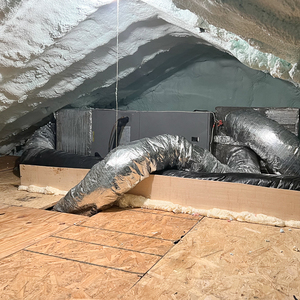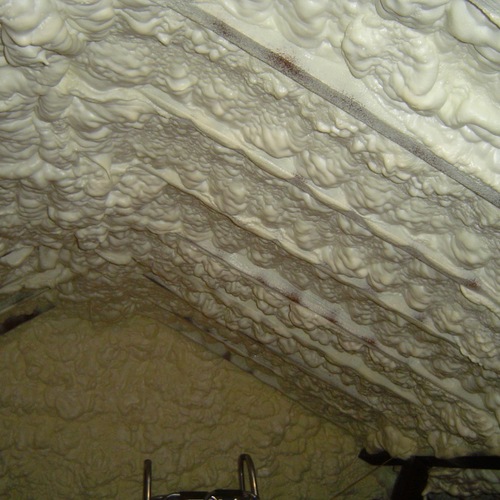
Some 280 million pounds of spray polyurethane foam goes into U.S. houses every year, and by most accounts the overwhelming majority of those installations go off without a hitch. Tom Harris, an industry veteran and now a spray foam consultant, says homeowners lodge complaints less than one-tenth of 1% of the time—a better record than the auto industry.
Some builders have deep misgivings about spray foam’s chemical makeup, particularly the global warming potential of some of its ingredients. But spray foam also has a number of appealing characteristics: the ability to fill irregular voids in wall and ceiling cavities, highly effective air-sealing, and, in the case of closed-cell foam, high R-values and excellent vapor control.
Advocates love foam. Yet installations can go wrong and when they do, it can get ugly. Take this case from 2018, logged at Saferproducts.gov, a website maintained by the Consumer Products Safety Commission. A 37-year-old woman reported that spray foam had been applied in the attic to replace old batt insulation, and within a day of moving back into the house the family’s health began going downhill.
“We experienced adverse health reactions,” the unnamed woman wrote, “post-nasal drip, headache, anxiety, and upper respiratory symptoms. Since the day it was sprayed, our home has had obnoxious odor on the second floor. It is worse on hotter days. We had to abandon the second floor of our home and completely separate the air.”
The woman continued, “I contacted the manufacturer since we do not know what to do about our unsafe living conditions. The smell has not gone away and the contractor that installed it doesn’t think there is a problem or refuses to accept that the product is faulty.”
According to a response filed by the company that manufactured the chemical components, an…
Weekly Newsletter
Get building science and energy efficiency advice, plus special offers, in your inbox.

This article is only available to GBA Prime Members
Sign up for a free trial and get instant access to this article as well as GBA’s complete library of premium articles and construction details.
Start Free TrialAlready a member? Log in















15 Comments
My advice to anyone trying to decide whether the risk of a bad spray foam job is an acceptable risk is twofold.
First, carefully consider using a different type of insulation. In all but a few situations, you can get better performance at lower cost with a different approach anyway, while also reducing climate impact (assuming you stay away from traditional HFC-blown XPS insulation which is has absurdly high climate impact).
Second, insist on a contractual arrangement that guarantees that the installer's insurance will pay for whatever remediation is necessary to completely resolve any problems. You might need a lawyer or other expert to review the contract and make sure you are adequately protected. You might scare away a lot of installers by asking for this, but that's probably a good thing.
Charlie,
Sound advice as usual.
What are examples of insulation that creates an air-seal and has similar R-Values to CC spray foam for the cost? I'd love to use those instead for my current project. Thanks!
There are many ways to air-seal other than expecting your insulation to also provide air-sealing. In fact, spray foam only air-seals the center of the wall cavity, not the edges and transitions where most air leaks happen anyway. Closed cell foam ages to about R-5.6/in; no low-carbon, low-risk insulation products can match that, but mineral wool is up to R-4.2/in and other fluffy insulation is around R-3.5 to R-4/in, so you just need a bit more of it. Open cell foam has about the same R-value as fluffy insulation.
Michael,
How do we square this with Martin's "Damp Roof Sheathing" article? This is what led us to choose CC spray foam on the underside of our unvented roof assembly.
https://www.greenbuildingadvisor.com/article/open-cell-spray-foam-and-damp-roof-sheathing
For unvented roofs insulated only from the interior, you do need to use closed-cell foam, but it's not because it's airtight--open-cell foam is also airtight--but because it greatly slows water vapor movement.
A wise person once said there are no bad products, there are only bad applications. In this case I'd say there are also bad installations.
As a rough ballpark, from what I've seen, I'd say that somewhere around one in 50 to 250 spray foamed projects has a curing problem. Maybe it's one in 500. That's a pretty low risk, but when it goes wrong, it's a major problem. I've never heard of a curing-related problem in any projects insulated with cellulose, fiberglass, mineral wood or wood fiber.
Add the health risk to installers, to others on the job site, the negative environmental impact, and the multitude of safe alternatives, and I don't see why anyone uses spray foam except in situations where nothing else will work. It's like driving a tractor-trailer truck to go grocery shopping.
Michael,
I'd analogize it to taking part in extreme sports. Perhaps the rewards are high, but they come with risks. To me the biggest problem is that customers aren't made aware of them.
I'm not sure I buy the argument of the problem always being the installers fault. Products that demand too high a level of perfection may simply have no place in the construction process.
One caveat to your extreme sports analogy - the rewards of performance are temporary while the risk to the environment (both GWP and non-recyclable) is permanent.
Even a perfect install still contributes to climate change and adds plastics to the environment that take hundreds, if not likely thousands of years to break down, ending up in the land, air and water supplies.
bgoldendesign,
Very good point.
Inability to recycle is yet another disadvantage. Not only is the spray foam itself not recyclable or reusable, it makes the wood or other material with foam attached not recyclable or more troublesome to recycle as well. Factory-manufactured foams don't have this problem. GBA contributors suggest people try to find recycled polyiso for lower cost materials.
Unfortunately there are consumers who are duped by contractors to believe that closed cell spray foam is "the best insulation", without mentioning the many negatives, partially to justify the higher costs. One consumer told me she planned to hire a contractor for $7,000 for closed cell spray foam for the underside of a single family home attic, with existing fluffy insulation on the attic floor.
Zero VOC foam?
Does anyone have experience with the new spray foam that is suppose to be very low or zero VOC?
It’s called Ultra-Pure made by Natural Polymers. I’m trying to secure enough for a 3300 sq ft home as it was released only a few months ago.
I'm curious how different Ultra-Pure actually is than other spray foams. Huntsman Proseal HFO and Lapolla Foam-Lok 2000 4G are both GreenGuard Gold, just like the Ultra-Pure is. Is the Ultra-Pure even better than GreenGuard Gold? Maybe, but at a quick glance it's hard to tell.
It sounds like these spray foam horror stories occur when the product is not installed correctly, so the fact that a correct installation results in a very low VOC final product doesn't necessarily mean you are safe from the odor problems that can arise from an incorrect installation.
Properly cured spray foam has little to no VOCs. Reading through that company's marketing materials, it looks like they may have a slightly different mix of chemicals that result in a lower risk of VOC release when installation isn't perfect. Like all spray foam manufacturers, they tout "zero ozone-depleting potential" which just means they aren't breaking a law that has been in place for 15 years, and all companies now offer reduced-GWP blowing agents. I would put little to no stock in their marketing efforts regarding VOC levels. Cellulose, fiberglass, mineral wool and other more environementally benign insulation have no VOCs.
It sounds like BS to me. If you read the technical datasheet, for only thing, it's only 8% bio-based. And the biobased foams have the same chemicals as petrochemical-based ones--it's just a different feedstock. Additionally, the datasheet emphasizes how important it is to get the parameters (temp, mix, etc.) just right, same as any other foam. And they have the same PPE and ventilation requirements as for the installation of any other foam, and they even refer to a document for the industry as a whole for guidance on the PPE--because it's not really significantly different from what's used industry wide.
Log in or become a member to post a comment.
Sign up Log in